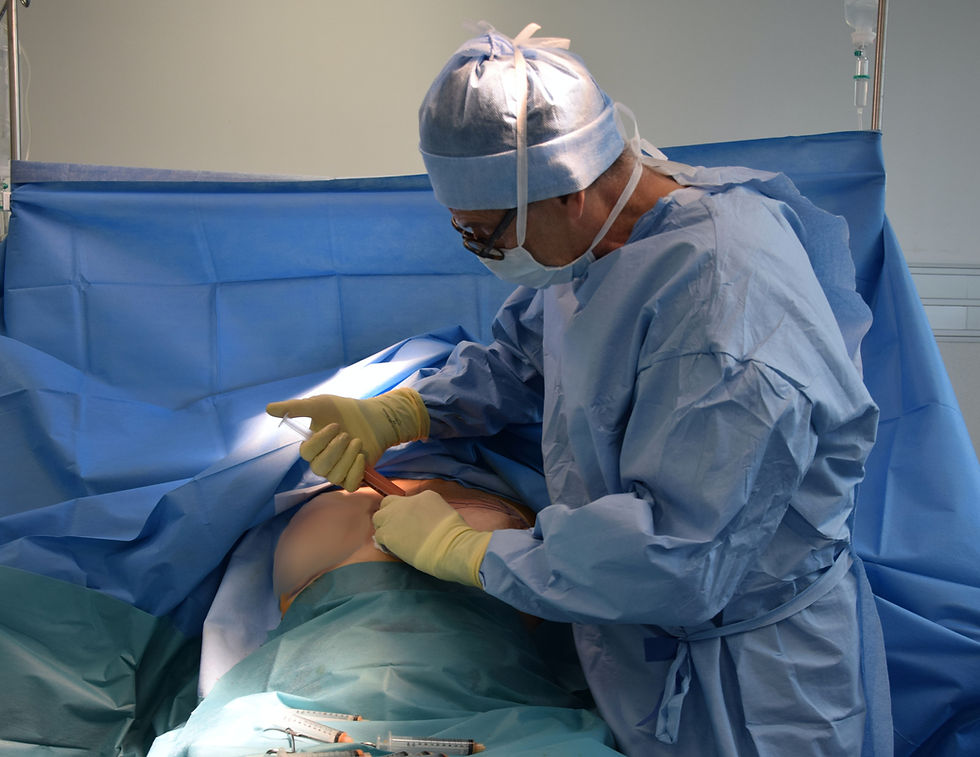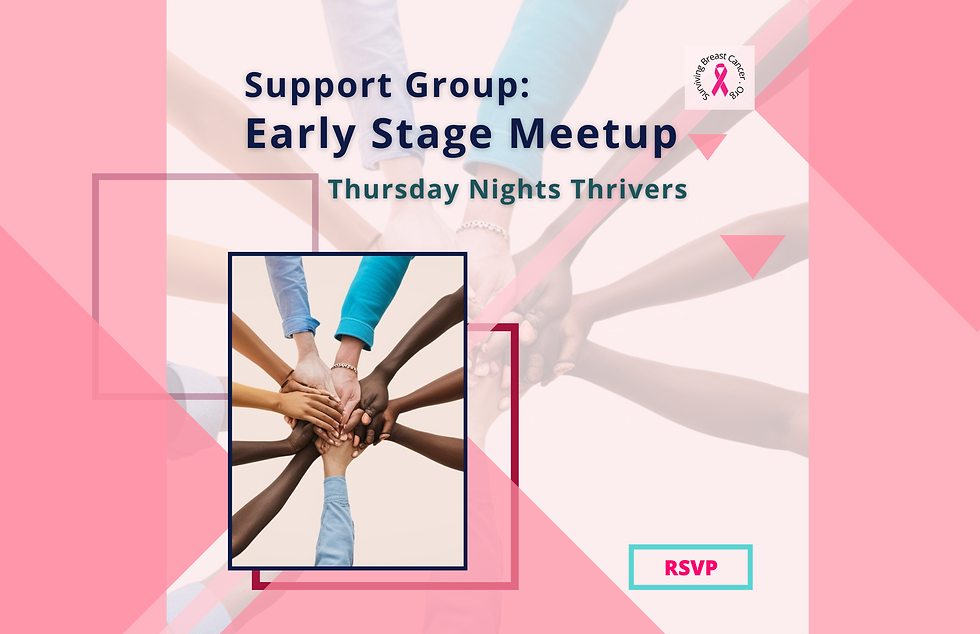Breast Reconstruction Surgery: Options, Considerations, and Recovery
- Surviving Breast Cancer

- Jan 14, 2024
- 5 min read
Updated: Oct 8

Breast reconstruction surgery plays a vital role in the physical and emotional recovery for many individuals who have undergone mastectomy or breast-conserving surgery. Understanding the options, considerations, and recovery aspects of breast reconstruction is crucial for making informed decisions and promoting post-surgical well-being. There are many different reconstruction techniques available. Take the time to learn about the breast reconstruction options and consider talking to others who have had that procedure before you make a decision.
Types of Breast Reconstruction
Different breast reconstruction procedures serve different purposes and preferences for breast cancer survivors. One of the following operations may help you realize your individual reconstruction goals and situation:
Implant-Based Reconstruction: Implant-based breast reconstruction may be possible if the mastectomy or radiation therapy has left sufficient tissue on the chest wall to cover and support a breast implant. Involves using saline or silicone implants to reconstruct the breast mound. It may require multiple surgeries to achieve the desired size and shape.
Autologous (Flap) Reconstruction: For patients with insufficient tissue on the chest wall, or for those who don't desire implants, breast reconstruction will require a flap technique (also known as autologous reconstruction). This uses the patient's own tissue, often from the abdomen, back, or thighs, to reconstruct the breast. It results in a more natural-looking and feeling breast, but is a longer and more complex surgery.
Combination Reconstruction: Utilizes a combination of implants and autologous tissue to reconstruct the breast.
Implants Above or Under the Muscle
Immediate Breast Reconstruction Above the Pectoral Muscle
This procedure is performed in combination with the mastectomy and results in an immediate breast mound. After the mastectomy has been performed by the breast surgeon, the plastic surgeon will place the breast implant, wrapped in a biological mesh known as acellular dermal matrix (ADM), to help the implant maintain correct anatomic position, above the pectoralis muscle.
With this procedure, recuperation may be more rapid because the muscle in the chest has not been elevated. Further, the breast implant itself is not influenced by the contraction of the muscle.
Immediate Breast Reconstruction Under the Pectoral Muscle
This procedure is also performed in combination with the mastectomy and results in an immediate breast mound. The incision is generally performed through the mastectomy site. Once the mastectomy is completed, the plastic surgeon will elevate the pectoralis major muscle. This will allow the muscle to retract upward and allow a pocket to be developed underneath the muscle and at the bottom of the normal breast position.
A biodegradable acellular dermal matrix (ADM) will be placed at the bottom of the breast or inframammary crease and attached to the muscle. The breast implant will be placed under the ADM and your own muscle. This allows the breast implant to settle in a normal position, and the ADM stretches into a pleasing, rounded lower breast shape. It is not uncommon to have drains placed with this procedure. They may be removed anywhere from 48 hours to 2 weeks after surgery.
This procedure is a one-staged procedure, which allows the desired shape to result without any further surgical intervention. The muscle on top of the implant will help prevent the development of upper pole wrinkling. Complications, while rare, may include skin loss, excess bleeding, infection, malposition of the breast implant so that asymmetry occurs, wrinkling or rippling of the implant, possible fluid collection underneath the implant and/or prosthesis deflation.

Delayed Breast Reconstruction Utilizing Tissue Expander
The initial portion of this procedure entails the breast surgeon performing a standard mastectomy and possible axillary dissection. In many instances, a drain will be placed between the muscle and the skin of the mastectomy.
Once these procedures have been performed, the plastic surgeon will divide the lower pole of the chest wall muscle, elevate the chest wall muscle and the lateral chest muscle together upwards towards the collarbone. After that is done, the muscle and tissue below are elevated together to form the pocket for the breast expander at the base of the breast or the inframammary crease. The pocket is made large enough for the expander to be placed and the muscle closed. Occasionally, there is a need for placement of a small amount of acellular dermal matrix (ADM) to assist in the closure of the muscle.
Two Types of Breast Tissue Expander Ports:
One, similar to a chemotherapy port, is placed separately from the tissue expander, usually along the rib cage. This will require a separate small incision for the port.
The second type is a port that is contained within the expander itself.
In both instances, the ports will be used to inflate the tissue expander over several visits with saline solution. The port is accessed with a small needle, and saline is injected into the expander through the port site
Tissue expansion usually occurs weekly according to patient tolerance. The volume of the tissue expanders commonly exceeds the weight of the mastectomy tissue. Once the final tissue expansion, or stretching, is completed, there will be a time of passive expansion where little to no volume is added to the tissue expanders. This allows the muscle and skin to stretch and relax.
The length of time will vary from patient to patient. Once this is completed, a second outpatient procedure will be necessary to remove the tissue expander and place the permanent breast prosthesis. Complications, while rare, may include skin loss, exposure of the expander, excess bleeding, infection, malposition of the implant so that asymmetry occurs, wrinkling or rippling of the implant, possible fluid collection underneath the implant, pain at the injection site, muscle spasms with expansion, and unfavorable scarring.
Immediate Breast Tissue Expander Placement
The surgical process for saline breast tissue expanders and breast expanders following mastectomy is the same. Expanders with saline have been used for decades, but recently, a new type of expander using air, which allows for more patient control, has been introduced. Expanders have some of the same complication rates and risks as the other types of breast reconstruction, which include infection, seroma, hematoma, extrusion, and expander deflation.
The expander is placed into a sub-muscular or subcutaneous space with no external filling ability. The expander will fill with compressed air contained within the expander itself. The patient will do self-controlled expander fills utilizing an external automatic activation device at home and will achieve similar results to the standard saline-filled tissue expansion devices. It will be necessary to monitor the incisions and progress on your own and contact the physician if you feel there is something wrong. The advantage of the expander it that it may decrease doctor visits and decrease total expansion time.
Considerations Before Surgery
Health Factors: Assessing overall health and discussing surgical risks with the healthcare team is crucial before opting for reconstruction.
Timing of Reconstruction: Reconstruction can be immediate (at the same time as mastectomy) or delayed (after completing cancer treatments).
Expectations and Goals: Discussing expectations regarding the surgical outcomes, including breast appearance, size, and symmetry, is essential.
Reconstruction Techniques: Exploring various reconstruction options and understanding their implications helps in making informed choices.
Recovery Period and Expectations
Hospital Stay: Depending on the type of reconstruction, hospital stays can vary from one to several days.
Pain Management: Managing post-surgical discomfort through prescribed medications and follow-up appointments is crucial.
Physical Limitations: Patients may experience restricted arm movement initially, requiring time to heal and gradually regain mobility.
Support Garments: Special bras or compression garments might be recommended to support healing and reduce swelling.
Emotional and Psychological Support
Counseling and Support Groups: Connecting with others who have undergone similar experiences can provide emotional support and valuable insights.
Body Image and Self-Esteem: Adjusting to changes in body image after surgery can be challenging. Seek support to address these concerns.
Recovery Timeline: Understand that emotional healing might take longer than physical recovery. Being patient with oneself is essential.
Follow-Up Care and Long-Term Monitoring
Regular follow-up appointments with healthcare providers are necessary to monitor the reconstructed breast, assess healing, and address any concerns or complications.











